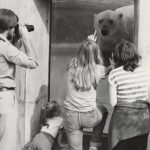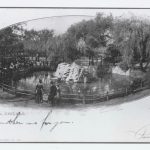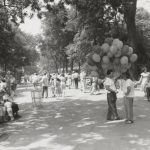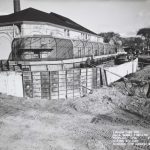The Lincoln Park Zoo has been a staple of Chicago for longer than anyone alive today can remember—150 years to be exact. Beginning in 1868 with a donation of four swans from New York’s Central Park Zoo, the zoo has morphed and expanded countless times. These changes display both the zoo’s push toward modernization and zoology’s transformation from simple animal viewing to scientific-based care and understanding of species and their natural habitats.
At the Lincoln Park Zoo, this transformation began in 1947 with the entrance of Lester Fisher, the zoo’s first veterinarian. In 1962, Fisher became Lincoln Park Zoo’s director and began pioneering a new kind of zoo: one that valued animal welfare and public education above collecting. During this time, more formal programming emerged, intended to engage the public with the animals beyond looking at them and touching them. The Farm-in-the-Zoo was built in 1962, along with the Lester Fisher Great Ape House in 1976. In 1989, the zoo began its Conservation and Science Department, which aimed to cultivate a better understanding of the animals in the zoo, their natural habitats and human/animal interaction. Alongside this push for understanding, the zoo began moving the animals out of the small, overcrowded cages they were kept in to larger areas that were more humane and better represented their natural habitats.
This shift did not end with Fisher’s retirement in 1992. If you visit the zoo today, you can see not only the animals, but also the plants and terrain that would be present in their true habitats. You can go to the zoo to see your favorite animal and leave knowing the environment they live in, the kind of food they eat and what you can do to help protect them.
Although it may surprise some, the zoo employs both researchers and scientists who help with conservation and public education. From the handwritten notes about animal behavior taken when the first researcher, Steve Thompson, was hired in 1990, to the innovative Zoo Monitor App now used to track both welfare and behavior of the animals, the researchers and scientists at the Lincoln Park Zoo have been an integral part of understanding and caring for these animals.
To celebrate this progress during the 150-year anniversary, Lincoln Park Zoo launched the exhibition From Swans to Science: 150 Years of Lincoln Park Zoo this summer. This 10-stop exhibition guides guests through various parts of the zoo, where they learn and interact with the zoo’s milestones, as well as its plans for the future. If you can’t make it there in person, you can visit the zoo's 150th anniversary website to interact with many informative resources, including a timeline, video and blog posts.
Additionally, you can visit CPL’s Special Collections to learn more about the history of the zoo through our Chicago Park District Photographs and Chicago Park District Drawings.
Special Collections and Preservation Division intern Emma Lipkin contributed this post. Lipkin is a senior at Lawrence University in Appleton, Wis., where she studies English and museum studies. Among other projects, Lipkin scanned 700 photos from Lincoln Park Zoo for our Chicago Park District Photograph Collection this summer.












Add a comment to: Lincoln Park Zoo Turns 150